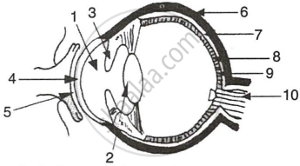Advertisements
Advertisements
Question
Differentiate between: Rods and cones
Solution
| Rods | Cones | |
| 1 | Rods help in twilight vision. | Cones help in colour vision. |
| 2 | They have visual purple pigment called rhodopsin. | They have visual violet pigment called iodopsin |
| 3 | Rods are the photoreceptor cells of the retina that are sensitive to dim light. | Cones are the photoreceptor cells of the retina that are sensitive to bright light. |
APPEARS IN
RELATED QUESTIONS
Answer briefly:
How do you perceive the colour of an object?
Distinguish between: aqueous humor and vitreous humor
The optical prescription for a pair of spectacles is :
Right eye : −3.50 D
Left eye : −4.00 D
Which is the weaker eye?
Name the part of the eye:
which changes the focal length of eye-lens.
What is the principal function of the eye-lens?
Where does the greatest degree of refraction of light occur in the eye?
Give the scientific names of the following parts of the eye:
a clear window at the front of the eye.
How does the convex eye-lens differ from the ordinary convex lens made of glass?
Why does the eye-lens not have to do all the work of converging incoming light rays?
Note the relationship between the first two words and suggest the suitable word/words for the fourth place.
Cones : Iodopsim :: Rods : ______.
Mention if the following statement is true (T) or false (F) Give reason.
Sometimes medicines dropped into the eyes come into the nose and even throat
Mention if the following statement is true (T) or false (F) Give reason.
yellow spot of the retina is the region of colour vision
Give Technical Term:
The fluid which conveys the vibrations of sound in the cochlea and semicircular canals.
Choose the Odd One Out:
Choose the Odd One Out:
Write the name.
The screen with light sensitive cells in human eye.
______ is tough and thick white sheath that protects the inner parts of the eye.
Write down the names of parts of the eye in the blank spaces shown in the figure.

Match the following:
| Column - I | Column - II | ||
| 1 | Retina | a | Path way of light |
| 2 | Pupil | b | Far point comes closer |
| 3 | Ciliary muscles | c | near point moves away |
| 4 | Myopia | d | Screen of the eye |
| 5 | Hypermetropoia | e | Power of accomodation |
The figure given below refers to the vertical section of the eye of a mammal. Study the figure carefully and answer the following questions.
 |
- Label the guidelines shown as 1 to 10.
- Write one important role of parts shown as 3 and 7.
- Write one structural difference between the parts shown as 9 and 10.
- Mention one functional difference between the parts shown as 6 and 8.
